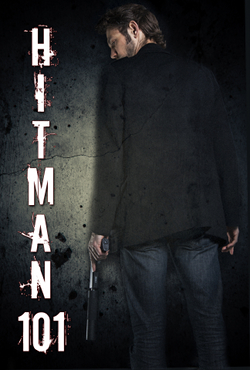Review: Brake (2012)
Cast: Stephen Dorff, Chyler Leigh, JR Bourne
Director: Gabe Torres
Country: USA
Genre: Crime | Thriller
Official Trailer: Here
Editor’s Note: Brake is produced by Walking West Entertainment in association with La Costa Productions. The film opens in limited release March 23rd.
The mechanics of reviewing the high-concept new thriller Brake — carefully selecting plot points as to avoid spoilers, framing observations with an eye towards impression rather than explanation — closely parallel the work done by the filmmakers and the film itself. Set almost entirely inside the trunk of a car, with only occasional and fragmentary glimpses of the world outside, the film establishes the claustrophobic and borderline existential predicament of Jeremy Reins (Stephen Dorff), a Secret Service agent trapped in a cramped transparent box, as initially clueless as the viewer as to how or why he got there. It becomes increasingly apparent that terrorists have kidnapped him and demand some special information about the President he’s sworn and been trained to protect. The central conceit brings easily to mind 2010′s Buried, in which Ryan Reynolds found himself in a coffin, and the tension-ratcheting mind games perpetrated by the unseen captors recall both Saw in its grimy aesthetic and Cube for its unpredictable dangers. There’s even an unfortunate moment too similar to the ill-fated Wicker Man remake for comfort. Yet what the film appears to lack in conceptual originality, it strains to make up with genuinely enveloping visual and sound designs and a capable lead performance.
…what the film appears to lack in conceptual originality, it strains to make up with genuinely enveloping visual and sound designs and a capable lead performance.
The impressively tactile visual scheme and aural design imbue the film with an engaging immediacy. Although the sense of sight is constrained by the enclosed space, director Gabe Torres and production designer John Mott engineer an impressively unsettling environment of tubes, wires, and glass in which to dump poor Agent Reins. A digital clock display attached to the box, soaking the inside of the unlighted trunk in blood red and ominously counting down to a further complication or indignity for the protagonist to endure, structures both the plot and viewer expectations into several minute intervals. When the time reaches zero and inevitably restarts, an escalation or raising of the stakes occurs, initially helping to stave off monotony in the story but eventually feeling like little more than another gimmick to prop up an episodic narrative.
 For the majority of the running time, all the other characters are voices piped in through speakers, on cell phones, or from the front seat of the car, their relaying of information the only source of plot points. This strategy deepens our identification with Reins, isolating us further into his visual and auditory perspectives. Kudos should definitely go to sound designer Richard Beggs and the entire sound department for fashioning effects that contribute more than anything to the scenario’s verisimilitude and plausibility, suggesting a chaotic world outside the trunk. From cars whizzing past to various electronic beeps and buzzers, the film’s sound holds and keeps the viewer in Reins’s head space as the plot unfolds.
For the majority of the running time, all the other characters are voices piped in through speakers, on cell phones, or from the front seat of the car, their relaying of information the only source of plot points. This strategy deepens our identification with Reins, isolating us further into his visual and auditory perspectives. Kudos should definitely go to sound designer Richard Beggs and the entire sound department for fashioning effects that contribute more than anything to the scenario’s verisimilitude and plausibility, suggesting a chaotic world outside the trunk. From cars whizzing past to various electronic beeps and buzzers, the film’s sound holds and keeps the viewer in Reins’s head space as the plot unfolds.
Ultimately, Brake‘s beating heart is lead actor Stephen Dorff. His career trajectory from a quirky leading man to a dependable genre stalwart plausibly culminates with Sofia Coppola’s Somewhere and this film, the former for relying on his lived-in bearing and Hollywood back-story, the latter for being a veritable one-man show that rises and falls with his performance. The viewer has no where else to turn here, in fact, but luckily Dorff’s expressive face and bursts of intensity cover for his general lack of range of motion and the viewer’s inability to leave his space. Even when kept in the dark at the film’s beginning, his character turns out to know more than he lets on to his captors (and to the viewer), adding a layer of ambiguity to the otherwise straightforward character, a layer that Dorff shrewdly sheds as the film progresses and he discovers the real motive for his kidnapping.
As much as it hinges on Dorff’s constrained physicality, Brake could also have easily been called Break, since his character’s most crucial trait, the one that maintains the plot’s momentum, is his unwavering dedication to protecting government secrets and not “breaking” under the barrage of threats and intimidation.
 As much as it hinges on Dorff’s constrained physicality, Brake could also have easily been called Break, since his character’s most crucial trait, the one that maintains the plot’s momentum, is his unwavering dedication to protecting government secrets and not “breaking” under the barrage of threats and intimidation. Without this steadfastness, the film’s just a man being tortured in a car trunk, so Dorff’s disintegration under the unfolding terrorist scheme is the film, essentially. His continual reorientation inside the clear, tomb-like container and increasingly bloodied and stained body hearkens to John McClane in Die Hard, another hero entrapped by circumstance. But whereas McClane used muscle, charm, and ingenuity to break from the confines of Nakatomi Plaza, Dorff’s Jeremy Reins has these traits drained from him until he seemingly can’t take any more.
As much as it hinges on Dorff’s constrained physicality, Brake could also have easily been called Break, since his character’s most crucial trait, the one that maintains the plot’s momentum, is his unwavering dedication to protecting government secrets and not “breaking” under the barrage of threats and intimidation. Without this steadfastness, the film’s just a man being tortured in a car trunk, so Dorff’s disintegration under the unfolding terrorist scheme is the film, essentially. His continual reorientation inside the clear, tomb-like container and increasingly bloodied and stained body hearkens to John McClane in Die Hard, another hero entrapped by circumstance. But whereas McClane used muscle, charm, and ingenuity to break from the confines of Nakatomi Plaza, Dorff’s Jeremy Reins has these traits drained from him until he seemingly can’t take any more.
Now to conclude my following of the film’s structure by expanding the range of discussion and breaking loose from the trunk, so to speak. Despite its keen use of aesthetic restrictions and Dorff’s affecting central turn, even a seemingly modest genre film like this one can’t seem to forgo a gut-punching plot twist or two, leaving the viewer not with a satisfying conclusion but in a questioning daze. Rather than convincingly forcing a reevaluation of what’s gone before, the ending strains even the most forgiving credulity, casting a bleak pall on memories of the preceding ninety minutes. Brake‘s stabs at real world significance by evoking government terrorism are both more and less insulting when considered in the conclusion’s wake, deflecting as it does one form of reality while implicating another, more frightening one. Its moral universe turns upside down in the space of a few minutes. The film ultimately ends by betraying, most distressingly, a trust in the compelling work of Stephen Dorff, who so admirably portrays a man being crushed within a collapsing world.
















 Review: The Raven (2012)
Review: The Raven (2012) Review: The Hunger Games (2012)
Review: The Hunger Games (2012) Review: Medianeras (2011)
Review: Medianeras (2011) Review: The Hunger Games (2012)
Review: The Hunger Games (2012)

